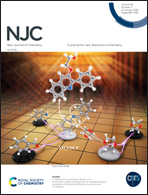Stabilizing XPbI3 (X = MA, FA and Cs) cubic perovskites by monolayer Ag4Se2 deposition†
Abstract
Organometallic and inorganic halide cubic perovskites with their bandgap tunability are favorable materials for various potential optoelectronic applications, but unfortunately suffer from notorious phase transition when temperature changes. While earlier studies involving the modification of monovalent cation sites and small molecule adsorption on perovskite surface showed thermal stability improvement, further investigation is still needed to improve their overall optical functionality. In this context, the formation of a heterostructure between two different materials is an effective route for promoting stability and modulating optical energy gap. Here, Ag4Se2–XPbI3 (X = MA, FA and Cs) stackings have been proposed, constructed and theoretically studied using the Grimme correction scheme, with negative interfacial binding energy varying between −0.109 and −0.410 eV Å−2. Important stability aspects, such as thermodynamical, mechanical and thermal, were determined and confirmed, attributing to the enhanced covalency introduced by additional Ag-d and Se-p orbitals, hitherto unrevealed in constituent phases. Apart from exhibiting superior ductility and improved carrier mobility up to 103 cm2 V−1 s−1, their HSE06 level computed bandgaps of 1.29, 1.79 and 0.70 eV are lower than those measured for constituent phases, resulting in power conversion efficiency exceeding 27.5% at an attainable thickness of 0.5 μm, high static refractive index n(0) exceeding 1.8 and steeper optical absorption, where α(ω) = ∼105 cm−1 is found spanning the infrared-visible region. Findings obtained show that Ag4Se2 deposition can complement existing material design strategies for advancing the stability of these fascinating yet problematic compounds.



 Please wait while we load your content...
Please wait while we load your content...